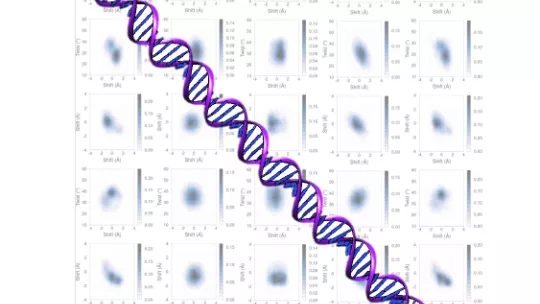Images
- The study presents a new mesoscopic (i.e., between microscopic and macroscopic) simulation model of DNA movement.
- This new model is essential to optimise research in the field of nucleic acids structural analysis.
- The study was published in the journal Nucleic Acids Research.
In both physics and chemistry, the mesoscopic scale refers to the length scale on which the properties of a material or phenomenon can be studied, without entering into a discussion about the behavior of individual atoms. In a mesoscopic model, atomic scales are merged with the continuous scale, so they are quite difficult to develop.
A new model of DNA flexibility has been developed by Kim López-Güell, a Maths4Life student, together with Dr. Federica Battistini, under the supervision of Dr. Modesto Orozco in the Molecular Modeling and Bioinformatics laboratory at IRB Barcelona. Using a low-cost computer program, the model developed, which considers the correlation and multimodality at tetramer level, provides results of unprecedented quality. The model is characterised by its precision and efficiency at the computational level, thereby making it an alternative approach to explore the dynamics of long DNA segments and opening up the possibility of getting closer to the chromatin scale.
“This work is a milestone in the mesoscopic simulation of DNA. It presents a systematic and comprehensive study of DNA movement correlations and a new method to capture them,” says Dr. Battistini, a postdoctoral researcher at IRB Barcelona.
Performed in collaboration with the “BioExcel” Center of Excellence for Computational Biomolecular Research, this work provides a greater understanding of sequencing-dependent DNA at the base pair resolution level. A variety of approaches and simplifications have been used to study this topic over decades but have failed to achieve a multimodal model. The method developed allows a local and global description with high precision for atomic-level molecular simulations and experimental measurements.
DNA movement as an axis
Molecular dynamics is a computational technique that allows simulation of the movement of DNA, its dimeric, trimeric, or tetrameric folding, and even its interaction with proteins and drugs. This technique enables scientists to study processes that occur on time scales ranging from picoseconds to minutes and that apply to molecular systems of various sizes and are therefore pivotal for research into cell functions and disease mechanisms.
This study clarifies how DNA movement works using an approach with a low computational cost that can predict the flexibility and conformation of long DNA strands, which could be extended to RNA duplexes and potentially long polymers. This new model is expected to benefit the scientific community working with nucleic acid simulations.
Related article
Correlated motions in DNA: beyond base-pair step models of DNA flexibility
Kim López-Güell, Federica Battistini & Modesto Orozco
Nucleic Acids Research (2023) DOI: gkad136
About IRB Barcelona
The Institute for Research in Biomedicine (IRB Barcelona) pursues a society free of disease. To this end, it conducts multidisciplinary research of excellence to cure cancer and other diseases linked to ageing. It establishes technology transfer agreements with the pharmaceutical industry and major hospitals to bring research results closer to society, and organises a range of science outreach activities to engage the public in an open dialogue. IRB Barcelona is an international centre that hosts 400 researchers and more than 30 nationalities. Recognised as a Severo Ochoa Centre of Excellence since 2011, IRB Barcelona is a CERCA centre and member of the Barcelona Institute of Science and Technology (BIST).








